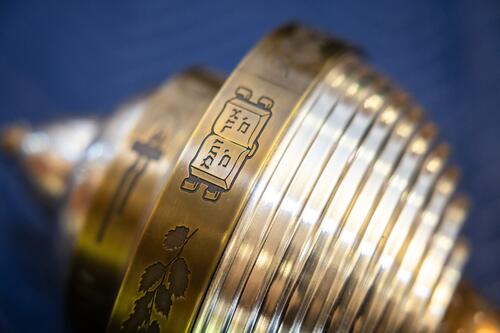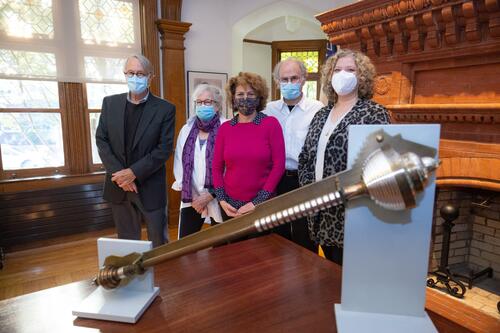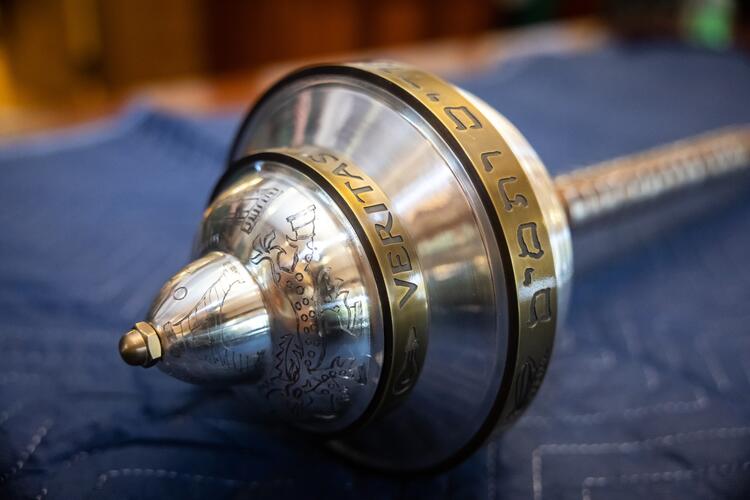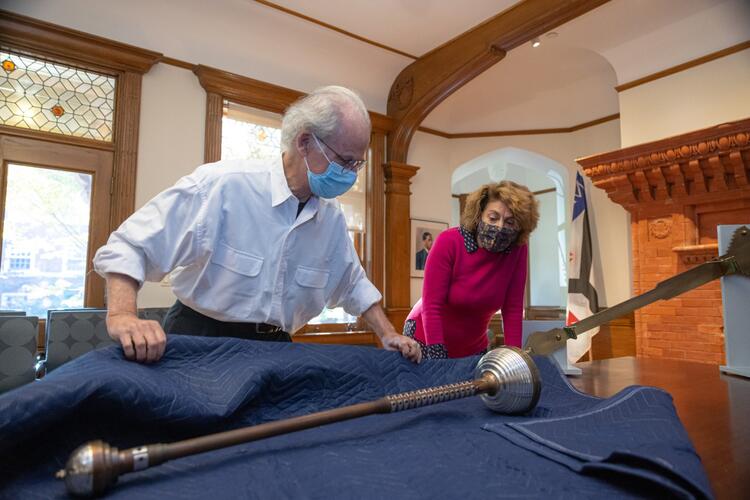
Story by Sebastian Rider-Bezerra, FAS Dean’s Office Communication Fellow, 2020-2021
Photos by Andrew Hurley, Office of Public Affairs and Communications
In 2019, Tamar Szabó Gendler, Dean of the Faculty of Arts and Sciences, commissioned artist and art restorer Howard Newman of Newport, Rhode Island to create a ceremonial mace to represent the Faculty of Arts and Sciences at official university ceremonies. The design and creation of the FAS mace was supported by a gift from Patricia and Kenneth McKenna ’75 PhD ’78, who previously sponsored the many beautiful mosaic tables that grace the Yale campus. The FAS mace takes inspiration from the maces of Yale College, the Graduate School of Arts and Sciences, Yale’s professional schools, and from the University Mace, a twenty-four-pound golden staff introduced in 1904 as a symbol of the President of the University and the Yale Corporation. As a symbolic representation of power and prestige, however, ceremonial maces and scepters date back thousands of years to the ancient Near East; the use of ceremonial maces in European countries began at least in the later Middle Ages and became widespread during the Renaissance.
For the FAS mace, Newman collected elements which were felt to be particularly emblematic of the FAS and then combined them with local touches and several whimsical flourishes to create an item of enduring symbolic significance. To represent Yale across the centuries, Newman chose to combine modern techniques such as laser engraving with the careful, hand-tool-based work of artists working in traditional styles—from “the ancients through today’s cutting edge,” as he put it.
 Newman first created a series of drawings, which he then modified and re-imagined in consultation with Dean Gendler and University Printer John Gambell. From these drawings, Newman was able to execute a half-scale model, which for the first time brought all of the elements together in an approximation of their final configuration. With this prototype approved, the fabrication of the individual elements could begin.
Newman first created a series of drawings, which he then modified and re-imagined in consultation with Dean Gendler and University Printer John Gambell. From these drawings, Newman was able to execute a half-scale model, which for the first time brought all of the elements together in an approximation of their final configuration. With this prototype approved, the fabrication of the individual elements could begin.
The shaft, or handle, the most substantial part of the mace, was turned on a lathe by Yale Provost Scott Strobel. The material, a piece of dark walnut, was originally taken from a tree on the Yale campus. In order to assure that such a long piece of wood turned true, Strobel divided the body of the mace into multiple lengths, so that the natural flexing of the wood as it turned on the lathe did not cause it to be unintentionally asymmetrical or, worse, to snap. The shaft was later stained blue, a color reminiscent of the blue so strongly associated with Yale.
Laser-cut into the bands which encircle the head of the mace are symbols emblematic of research and teaching in the FAS: items as diverse as the Latin word for ‘truth’, an LED bulb, the Sheffield School’s famous zeppelin window, and the popular ankylosaurus from the Peabody Museum’s Rudolph Zallinger mural. The rings which encircle the shaft were made by Don Nguyen of Providence, Rhode Island, and laser-engraved by LNA Laser in Pawtucket.
The counterweight at the other end of the shaft, meanwhile, is decorated with the yael, a beast from medieval European mythology and heraldry, which features prominently on the FAS coat-of-arms. As the legend goes, the goat-like creature with boar-like tusks and horns can rotate those horns on command to defend itself. The version of the yael used on the mace was first drawn by Newman and then painstakingly engraved by hand into the metal by Adam Amara and Eugenia Organova.
 Originally, the mace was intended to be ready for commencement in 2020, but the arrival of the coronavirus pandemic forced a reappraisal of plans for graduation. It will be carried with pride in all subsequent ceremonies. While it awaits its call to duty, the mace will be displayed in a custom-designed mount in the office of the FAS Dean on Hillhouse Avenue in New Haven.
Originally, the mace was intended to be ready for commencement in 2020, but the arrival of the coronavirus pandemic forced a reappraisal of plans for graduation. It will be carried with pride in all subsequent ceremonies. While it awaits its call to duty, the mace will be displayed in a custom-designed mount in the office of the FAS Dean on Hillhouse Avenue in New Haven.
Despite this formal and ceremonial context, the mace contains many touches of whimsy or humor when viewed up close. Just below the head of the mace are a series of yellow points intended to evoke the tassels of a jester’s cap. Even the shape of the head of the mace itself was designed with reference to the shape of the Faculty of Arts and Sciences’ organizational chart. The head is filled with stones taken from the banks of the Quinnipiac River, giving the mace weight and heft, providing an unexpected sonic element, and offering tribute to the indigenous inhabitants of the area where Yale is built.
A final detail situates the mace as part of Yale’s institutional history. Along the shaft, beginning just below the head, a series of metal bands will eventually bear the names of the successive Deans of the Faculty of Arts and Sciences. For now, the only names it bears are those of the donors whose generous gift made the mace’s creation possible, and that of the inaugural FAS Dean who comissioned it, Tamar Szabó Gendler.


Artist Howard Newman presents the mace to Dean Tamar Gendler:

